Dental implants
Dental implants are like artificial roots of teeth made of titanium which are placed into the jaw. Dental implants give support for crowns, bridges and removable dentures. The basic parts of a dental implant are: fixture and abutment.
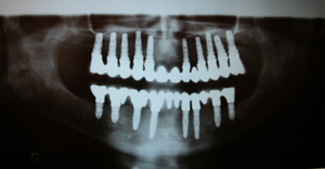
Different sizes and shapes are available for all kinds of individual cases. As a temporary solution, following a three to six months long healing period you will receive a prothesis fixed on dental implants. It has the same features as natural teeth and it can take over the original function of the denture. Replacing the missing teeth by means of implant dentistry will provide you better comfort, aesthetics and harmony of your face with better function in smiling, chewing and biting.
Crowns on implants resemble natural teeth, therefore no one will notice them. For a perfect aesthetic result, choose zirconium crowns made of 100% ceramic.
Dental implants allow you to regain your chewing reflexes and find your best communication skills that are essential in your private and professional life.
Advantages of implant dentistry
Professional clinical experiences show that over 95% of implant placements are successful. Over 90% of dental implants remain in perfect condition, even after a decade. For example, the CAMLOG® Implant System is a leading supplier of comprehensive systems and products for implant dentistry and restorative dentistry. CAMLOG® SCREW-LINE implants have been among the most used implant types world-wide for years. Numerous studies attest the good results in long-term survival rates.
If you need a bridge: there is no need to file off the neighbouring healthy teeth when preparing them for bridge work. The replacement of a missing tooth is easy with dental implants.
Missing molars: Forget about the removable dental appliances, considered as characteristics of old age. Porcelain crowns fused to metal placed on the implants are much more comfortable and functional, not to mention their aesthetic result: modern ceramic materials ensure a perfect reproduction of natural teeth. In case of three missing molars at the back of the mouth, a bridge fixed on implants is the only long-term solution. Without implants, conventional prosthesis would never insure the same stability or the same functionality. Replacing your molars with dental implants guarantees extraordinary stability that will allow you to eat whatever you want.
Are you toothless? Some dental implants are enough to ensure stable and attractive teeth that do not move when you eat or speak. You do not have to settle for dentures, there is a fixed or semi-removable prosthetic reconstruction of the upper or lower jaw.
Dental implants help prevent the inevitable deterioration of bone mass due to loss of teeth. They help keep stability and comfort during speaking and chewing. They help you feel comfortable in all circumstances.
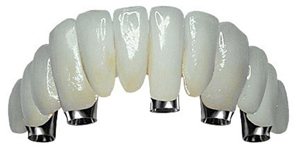
Material of implants
Implants are made of pure titanium which is a special biocompatible material and highly reputed in medical technology. It provides a perfect coexistence with human tissue which is very important during the integration to the jaw bone (osseointegration), does not cause rejection; these are the criteria for selecting fabrication materials. In other words, only bio-materials are retained. Titanium corresponds perfectly with these parameters. Dental implants do not cause allergic reactions to the human body.
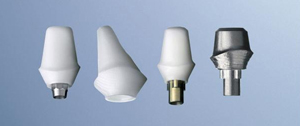
Who can get dental implants?
The ideal candidate: be in good general health, have good oral-hygiene, have an appropriate jaw shape and have enough bone in the area where the implant will be placed. This area must be completely healthy and free of inflammation.
Any decay and inflammation must be treated before the implantation. If necessary, the bone volume will be increased by appropriate techniques (see the chapters on bone filling and bone grafting).
It is important to know that certain diseases or addictions contraindicate implantation or require a particular approach. These are: diabetes, hemophilia-like disorders, the use of certain medicines and smoking.
Only an accurate assessment of health condition of the patient can decide about such an intervention.

The risk of implant surgery
Most of the implants are placed in local anaesthesia. The procedure causes no pain or discomfort. The next day you can return to normal activity. Complications that may occur are similar to those related to other medical procedures done under local anaesthesia.
During the dental implant placement it is theoretically possible to injure neighbouring structures such as the inferior dental nerve, sinus cavity, or adjacent roots. With right technique and planning these risks are minimal.
The number of implant rejections is relatively low: approximately 2% of all cases.
Steps of implant surgery
The procedure requires a thoughtful approach from the dental surgeon and the dental technician alike when it comes to the planning and the execution of the treatment.
The treatment begins with enquiring about the general health condition of the patient, his diseases and medications taken. Then it proceeds to a thorough dental examination. The panoramic X-ray is mandatory in all cases. A CT scan might be needed, for instance estimating the sufficient amount of bone mass.
A dental impression is taken at the very beginning to make a study model (and possibly a temporary prosthesis). With the help of this model, the dental X-ray and a clinical examination, the dentist will be able to decide on the possibility of implantation. In certain cases, the intervention must be preceded by a blood test.
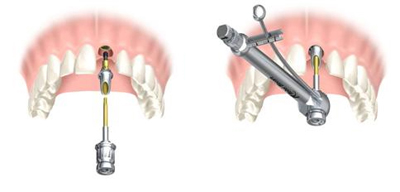
Placement of dental implant
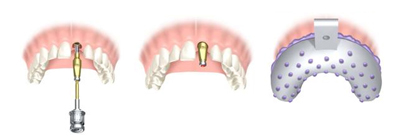
Atteching the dental implant's head to the implant
The procedure takes place under local anaesthesia without hospitalization. A mucosal incision is made to free the area of the jaw where a small cavity is formed first. Once the artificial root has been placed into the jaw, the gum is closed with absorbable stitches.
After surgery, there is a healing period of approximately four or six months. During this time, the implants fuse to the bone by a process known as ‘osseointegration’. During this phase, a temporary denture could be considered to replace the absence of teeth.
The procedure can result in a slight swelling of the face which is quite normal, and does not cause major pain. During the healing period a regular follow-up is necessary. Next, there is a minor surgical exposure of the top of the implant, whereby the dentist will attach the post to the implant. The function of the post is to become the support for either one tooth or a set of teeth. This is a short procedure that usually requires only local anaesthesia.
The last phase is the restorative phase. The dentist will take impressions and then make a prosthesis that will attach to the implants. This will require several visits. Once completed, your mouth will be restored to natural looking, strong teeth.
Pre-and postoperative instructions
To ensure proper integration of the implant to the bone, as quickly and naturally as possible, rest and patience are particularly important as any healing process takes time. Healing time depends on factors such as the quality and quantity of the bone mass. During the first days following the operation, you should avoid anything that could dry the area of implantation. Make sure that you maintain a gentle and effective dental hygiene. This way you can prevent bacterial infections that may impair the healing of your implants.
- Do not chew hard food.
- Retrain from smoking and drinking alcohol as long as possible. Both hinder the healing process.
- Avoid intense physical activity to avoid bleeding of the operated area.
- Once the effect of anaesthesia is gone, eat only soft, tepid or cold foods, avoid hot meals.
- Alcohol, coffee and physical activity increase blood pressure, and can cause bleeding, therefore it is better to avoid them for a while.
- Rinse gently, do not spit, do not smoke, do not use straw because these can stimulate bleeding.
- If you experience any bleeding, bite on a strip of sterile gauze for fifteen minutes. If the bleeding does not stop, call us at the clinic.
- It is possible to reduce the swelling by using ice packages on the face.
- Eat soft or boiled foods. Avoid the consumption of dairy products and beer.
- Brush your gums very gently with a soft toothbrush 2 – 3 times daily in a circular motion
- Use Corsodyl mouthwash after meals
Pain, swelling, limited mouth opening may be present and may intensify in the days after surgery, particularly in the morning. This reaction is quite normal, from the fourth day, the swelling decreases. If the swelling is still significant or it intensifies, please call us at the clinic. After the operations, customers receive a complete set of drugs which includes analgesics, antibiotics, mouthwash, ice packs and a document about post-operative instructions.
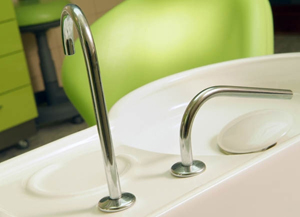
There are few things you should know about implants based crowns/bridges
The implantation is an investment which can bring you great benefits, so you will have a pleasant smile for the rest of your life. However, proper dental care is essential if you want to enjoy all the benefits of your new teeth for a long time.
Two annual visits are recommended for optimal maintenance of implants. It is also suggested to have a dental cleaning (scaling) at least once a year. Pay attention to your oral hygiene. If necessary, use an interdental brush, superfloss and dental floss. Once the implant is placed and crowns are fitted, your dentist will show you the most appropriate technique for brushing.
The long-term effects of the intervention also depend on you. The responsibility of the dentist mainly covers the period over the crowns are fitted. After a while, appropriate maintenance is mostly the patient’s responsibly. Approproate oral hygiene should prevent any inflammation around the implants which may cause an implant rejection.
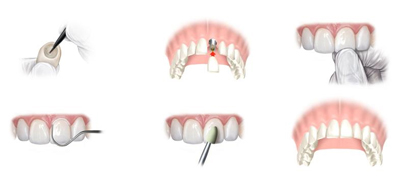
 Français
Français  Русский
Русский  English
English 



